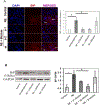Catecholamines Induce Endoplasmic Reticulum Stress Via Both Alpha and Beta Receptors
- PMID: 31232864
- PMCID: PMC6920607
- DOI: 10.1097/SHK.0000000000001394
Catecholamines Induce Endoplasmic Reticulum Stress Via Both Alpha and Beta Receptors
Abstract
Severely burned patients suffer from a hypermetabolic syndrome that can last for years after the injury has resolved. The underlying cause of these metabolic alterations most likely involves the persistent elevated catecholamine levels that follow the surge induced by thermal injury. At the cellular level, endoplasmic reticulum (ER) stress in metabolic tissues is a hallmark observed in patients following burn injury and is associated with several detrimental effects. Therefore, ER stress could be the underlying cellular mechanism of persistent hypermetabolism in burned patients. Here, we show that catecholamines induce ER stress and that adreno-receptor blockers reduce stress responses in the HepG2 hepatocyte cell line. Our results also indicate that norepinephrine (NE) significantly induces ER stress in HepG2 cells and 3T3L1 mouse adipocytes. Furthermore, we demonstrate that the alpha-1 blocker, prazosin, and beta blocker, propranolol, block ER stress induced by NE. We also show that the effects of catecholamines in inducing ER stress are cell type-specific, as NE treatment failed to evoke ER stress in human fibroblasts. Thus, these findings reveal the mechanisms used by catecholamines to alter metabolism and suggest inhibition of the receptors utilized by these agents should be further explored as a potential target for the treatment of ER stress-mediated disease.
Figures






References
-
- Peck MD: Epidemiology of burns throughout the world. Part I: Distribution and risk factors. Burns : Journal of the International Society for Burn Injuries 37:1087–1100, 2011. - PubMed
-
- MD P: Epidemiology of burns throughout the world. Part I: Distribution and risk factors. Burns 37:1087–1100, 2011. - PubMed
Publication types
MeSH terms
Substances
Grants and funding
LinkOut - more resources
Full Text Sources

